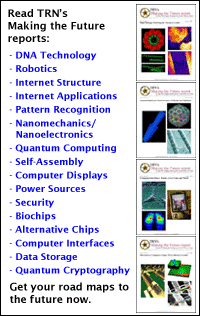
Laser switch sets up logic
By Eric Smalley, Technology Research NewsThe long-held dream of building all-optical computers could be another step closer to reality with the development of a prototype photonic transistor.
The electronic transistor is the basic building block of today's computer logic circuits. Transistors use an electric current or field to amplify another electric current, creating electronic pulses that represent the ones and zeros of binary computing.
But it's extremely difficult to do the same with light beams. A team of researchers based at the National Institute of Advanced Industrial Science and Technology (AIST) in Japan, however has found a way to make a red laser beam amplify a blue laser beam by as much as 60 times.
Perhaps more importantly, the researchers should be able to build the necessary components in thin films of silver oxide, which means the photonic transistors could be built into computer chips.
"[By] combining the transistor with [semiconductor lasers], integrated photonic circuits will be possible, and not so difficult [to build]," said Junji Tominaga, head of the Laboratory for Advanced Optical Technology at AIST.
Integrated optical circuits have the potential to be 100 times faster than integrated electronic circuits. Optical computers could also transmit data directly over fiber-optic cables. Connecting electronic computers to optical networks requires optical-electronic converters, which are slow compared to the computers and networks themselves.
The researchers' prototype photonic transistor consists of a red laser and a blue laser aimed at opposite sides of a spinning, CD-like disc. The key to the prototype device is a two-step process for transferring energy from the red laser to the blue laser.
The researchers first recorded a series of tiny marks in the disc in the same manner as DVDs are recorded. They then aimed the red laser at the marks, which caused plasmons to form inside the marks. Plasmons, which are waves of electrons on the surface of a metal, store energy.
The red laser broke down a silver oxide layer in the disc, which created tiny particles of silver. The silver particles scatter light, and when a particle forms above a plasmon it discharges the stored energy. The researchers positioned the blue laser beam to receive this discharged energy.
Changing the power of the red laser changes the size of the silver particles, which in turn determines how much energy is transferred from the plasmon to the blue laser beam.
But it's a long way from the prototype to optical computer chips.
"This [research] is very exciting, although it is not quite clear to me how such a structure would be implemented practically," said Olivier J. F. Martin, a professor of nano-optics at the Swiss Federal Institute of Technology.
"In particular, the switching process relies on the [red] illumination beam, which plays the role of the gate in this ‘photonic transistor’," he said. "How this illumination beam can be modulated remains the key issue for an all-optical transistor," and the researchers have not addressed this, he added.
The researchers' next step is to replace the disc with waveguides, which, like optical fiber, channel light, said Tominaga. Waveguides etched into chips are likely to be a critical component of future integrated optical circuits. Practical application of the photon transistor could be possible in five to ten years, he said.
Tominaga's research colleagues were Christophe Mihalcea, Dorothea Büchel, Hisako Fukuda, Takashi Nakano and Nobufumi Atoda of the National Institute of Advanced Industrial Science and Technology in Japan, Hiroshi Fuji of Sharp Corporation, and Takashi Kikukawa of TDK Corporation.
They published the research in the April 23, 2001 issue of the journal Applied Physics Letters. The research was funded by the Ministry of Economic Trading and Industry in Japan.
Timeline: 5-10 years
Funding: Government
TRN Categories: Optical Computing, Optoelectronics and Photonics; Integrated Circuits
Story Type: News
Related Elements: Technical paper, "Local plasmon photonic transistor," Applied Physics Letters, April 23, 2001
Advertisements:
May 23, 2001
Page One
Laser switch sets up logic
Light computer runs quantum algorithm
Five percent of nodes keep Net together
Prototype shows electronic paper potential
Lasers spin microscopic objects


News:
Research News Roundup
Research Watch blog
Features:
View from the High Ground Q&A
How It Works
RSS Feeds:
News
Ad links:
Buy an ad link
| Advertisements:
|
 |
Ad links: Clear History
Buy an ad link
|
TRN
Newswire and Headline Feeds for Web sites
|
© Copyright Technology Research News, LLC 2000-2006. All rights reserved.